| Pages:
1
..
3
4
5
6
7
..
9 |
Hennig Brand
International Hazard
    
Posts: 1284
Registered: 7-6-2009
Member Is Offline
Mood: No Mood
|
|
Thought I'd post a few pictures of the over head stirring device I made for those thicker nitration mixtures. The nitration in the pictures was a 50g
erythritol nitration using ammonium nitrate and 91% sulfuric acid. The stirrer was made in minutes, but I had been thinking about how to do it off and
on for a long time. A second hand cordless screwdriver was used which was purchased from a thrift shop for $2. The battery was missing, but would not
have been of much use anyway. An old computer power supply was used to supply the ca. 3V and high current needed to power the screw driver. A piece of
10mm Teflon rod about a foot long (IIRC) was used as the shaft. A slice from a Teflon runner found at a scrap yard was used as the paddle. The rod was
drilled and threaded. The paddle was also threaded with the same thread and then the two were screwed together. Running the stirrer clock-wise causes
the threaded connection to tighten not loosen in use. The little screwdriver can provide a lot of torque, given the powerful dc motor and gear head
assembly. The Teflon shaft was connected to the screwdriver using a slightly undersized piece of stiff polyethylene tubing used as a coupling. The
tubing was made very soft by placing it in boiling water and then forced on the screwdriver shaft and Teflon rod. During the nitration, after adding
all the erythritol the stirring was continued for over an hour before dilution of the nitration mixture. The stirrer got only slightly warm after this
use, even though it was a hot summer day (>25C).
A much larger stirrer could be made. Cordless drills could also be used. They are usually much more powerful than cordless screwdrivers and can often
be obtained very cheaply or for free.
BTW, the process was made much smoother and much more enjoyable by using the overhead stirrer. Yield was about 1.45g of recrystallized from methanol
ETN per gram of erythritol.
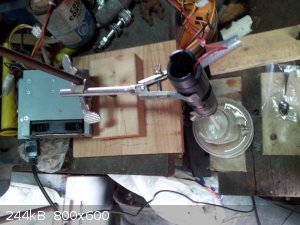 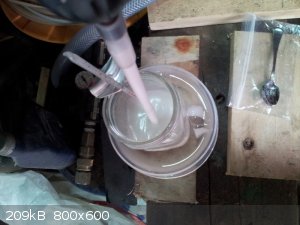 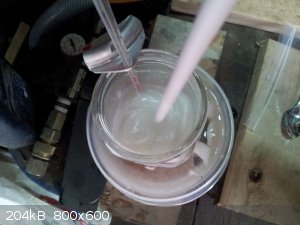 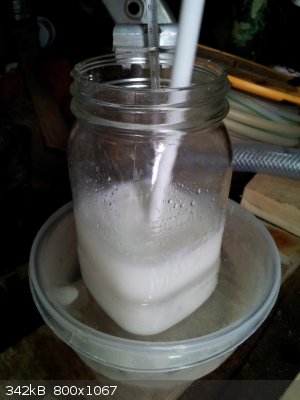 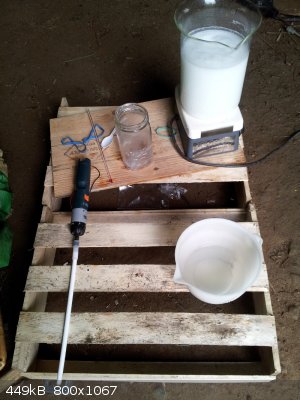
I notice that I didn't have the stirrer and reaction vessel directly in line with each other, but the set-up still seemed to work ok.
[Edited on 28-7-2014 by Hennig Brand]
"A risk-free world is a very dull world, one from which we are apt to learn little of consequence." -Geerat Vermeij
|
|
|
roXefeller
Hazard to Others
  
Posts: 463
Registered: 9-9-2013
Location: 13 Colonies
Member Is Offline
Mood: 220 221 whatever it takes
|
|
How the ___ do you come across random bits of teflon junk for repurpose?
|
|
|
Hennig Brand
International Hazard
    
Posts: 1284
Registered: 7-6-2009
Member Is Offline
Mood: No Mood
|
|
Teflon is used for a lot of things commercially and industrially. Just a few miles down the road from where I grew up is a scrap yard that up until
5-10 years ago, when there were several booming mills in the area, had a lot of surplus industrial equipment and building materials. The scrap yard
got many of the contracts for the mills' junk, when there was demolition, modifications, rebuilds, expansions, upgrades, etc to the mills. To make a
long story short, there was a lot of old industrial equipment and bits of random material lying around. I also order Teflon round stock from time to
time, which is very expensive compared to what it costs for the stuff I find in the scrap yard. For example the one foot length of round stock used
for the shaft above cost me about $15-20, while the paddle/stirring bar was cut from a 4-5 foot long piece of used Teflon runner that I picked up for
$5. I still find materials at the scrap yard, but not as much as before when there was more industrial and commercial activity in the area. Teflon is
more rarely found than other plastics, but there are always a few pieces around.
I was going to try a piece of 304 or 316 stainless steel as the stirrer shaft, but never got around to it. It would be strong, straight and it should
be quite resistant to the mixed acids (I think), as well as being more easily found as scrap and cheaper than Teflon. The stainless steel mixer
attachment, posted about above, most likely was made of a lower grade stainless (not 300 series). Stainless steel welding rods come in a wide variety
of compositions so that might be a good source depending on what rod dimensions were available. The flux can be simply knocked off and the rod sanded
a little to remove the last bit for the rods that come coated in flux. A lot of Teflon paddles could be cut from a relatively small piece of Teflon
sheeting.
[Edited on 21-8-2014 by Hennig Brand]
"A risk-free world is a very dull world, one from which we are apt to learn little of consequence." -Geerat Vermeij
|
|
|
NeonPulse
Hazard to Others
  
Posts: 417
Registered: 29-6-2013
Location: The other end of the internet.
Member Is Offline
Mood: Isolated from Reality! For Real this time....
|
|
I have a similar unit made from an old electric motor with a PWM unit attached this way the speed can be adjusted to suit the mixtures viscosity. The
only problem is there is not enough torque to keep it moving when the mixture really thickens up. Maybe I could use a screwdriver setup like this and
eliminate that problem. This is a good idea. I also use a clamp attached to an adjustable arm to hold the thermometer in place as to not have it in
the way. The only problems I can see with this setup is how I would be able to quickly get the beaker into a Quenching bucket should a runaway occur?
Its not exactly quick to release the toggles on both arms holding the stirring unit and thermometer in place and a runaway would likely be in full
swing fuming sputtering and hissing as well as showering the area with acids. Im curious to know if that were to happenHow would you deal with that
event? Maybe ill keep it near an edge with a bucket below and push it in with a stick.....
|
|
|
Hennig Brand
International Hazard
    
Posts: 1284
Registered: 7-6-2009
Member Is Offline
Mood: No Mood
|
|
I guess I would switch off the power to the stirring motor then pick up the lab stand and all, which would pull the stirrer paddle and rod up out of
the reaction vessel. The reaction mixture could easily be drowned in water then. Just make sure the lab stand is heavy or weighted enough to hold the
stirrer steady even when stirring viscous mixtures, but not so heavy (or anchored) that it can't be moved easily and quickly if need be. Of course
keeping enough cold water close by to drown the reaction mixture is a must and goes without saying. You are right; it is good to think of these things
before they happen. Luckily I have never had a runaway with ETN, but that doesn't mean that it will never happen.
The cordless screwdrivers have fairly good torque and the speed could be varied with PWM or even just voltage variation probably. The stirring speed
of the cordless screwdriver is not really all that fast, but it seemed to work pretty well anyway (with a big enough paddle). A cordless drill would,
however, have even more torque and give you a greater range of stirring speeds.
The Teflon rod I am using for the stirrer shaft has a slight curve to it. The stirrer still works fine, but I imagine it will increase wear and tear
on the gear head of the cordless screwdriver or drill. Actual laboratory Teflon stirring shafts are normally Teflon coated steel, not pure Teflon from
what I understand and are very straight. I was thinking of using an external bearing positioned just below the cordless screwdriver or drill which
could take the abuse. The bearing in place would mean that the driver motor and gear head would see much less undesirable/damaging movements, only
nearly perfect rotation. Maybe it isn't worth the trouble, since second hand cordless tools can often be found so cheap anyway. It may not be much of
an issue anyway except for slightly greater long term wear and tear.
Just had a thought, if you wanted the stirrer stand/lab stand to be really secure, yet easy to move when needed, a wooden box/receptacle could be made
and anchored to the bench. The base of the lab stand could sit in the anchored box (assuming a square or rectangular lab stand base). It should be a
snug fit. It would hold the lab stand very securely, preventing any kind of sideways motion, but would still allow the stand to be lifted straight up
if the stirrer assembly had to be removed quickly. A receptacle for the stand base could be made circular, or in other shapes if need be, but that
would be a little more difficult than a box.
[Edited on 25-8-2014 by Hennig Brand]
"A risk-free world is a very dull world, one from which we are apt to learn little of consequence." -Geerat Vermeij
|
|
|
goldenoranges
Harmless

Posts: 42
Registered: 25-1-2014
Location: Huge Corrugated Pipe
Member Is Offline
Mood: Giddious
|
|
It is weird, I never get my mixture to get thick, and this is my personal recipe on making it;
| Code: |
Needed:
2 glass beakers ~100ML
Bath container
Sulfuric Acid 98%
70% Nitric Acid
Erythritol
Water
Bicarbonate
Filters
Filter Holder
Ice, Salt, Bath
NO HIGHER 30f, Keep around 20f
Salt - Ice Bath
12ml 70% Nitric Acid Added Carefully
18ml 98% Sulfuric Acid Added Carefullly
30f Not to be Passed
Bit By Bit, Add Sulfuric and Nitric together
When done and cooled down
3g Erythritol, while stirring, small portions
temp around 20f
Stir 30 MINUTES
Crash Contents into Cold water, rinse beaker
filter precipitation after it is done 10minutes should be good
make bicarbonate solution, pour on top of filter onto crystals neutralize it
rinse with water again and again get rid of bicarbonate
let dry |
I follow that exactly, it gets me a pretty darn good yield, but it never gets thick? It gets thicker than it was when I first added everything, I have
heard of people breaking glass stirring rods while making it though, and it is about the same consistency as 20w motor oil. Does anybody know why this
might be? I am at a high altitude, that is the only reason I can think of since I am following a pretty standard method for making ETN.
[Edited on 8-9-2014 by goldenoranges]
Knowledge is the Ultimate Power.
PGP Key is in Bio
|
|
|
roXefeller
Hazard to Others
  
Posts: 463
Registered: 9-9-2013
Location: 13 Colonies
Member Is Offline
Mood: 220 221 whatever it takes
|
|
My first thought is you are using 70% nitric acid. Are you comparing it to posts that use sulfuric and alkali nitrate? The extra salt from the in
situ nitric acid reaction would cause a thicker mix.
|
|
|
goldenoranges
Harmless

Posts: 42
Registered: 25-1-2014
Location: Huge Corrugated Pipe
Member Is Offline
Mood: Giddious
|
|
Hmm that must be the reason why. I never saw what they were using exactly, all I read was that it was a thick mixture. I didn't question it that much.
Oh well, it is better it isn't thick, it would make it more of a hassle to stir, and I wouldn't be able to use my magnetic stirrer haha.
Knowledge is the Ultimate Power.
PGP Key is in Bio
|
|
|
NeonPulse
Hazard to Others
  
Posts: 417
Registered: 29-6-2013
Location: The other end of the internet.
Member Is Offline
Mood: Isolated from Reality! For Real this time....
|
|
I used to use 95%+ nitric acid for my synthesis so there's less liquid in the mix as well as doing 30g batches. Trust me, when the temp is around the
20℃ mark and the reaction is nearing completion the mixture is chock full of ETN and it can be pretty thick. It is even thicker if you use the
potassium nitrate method. Its nearly impossible to stir efficiently making cooling a problem too.
|
|
|
Metacelsus
International Hazard
    
Posts: 2531
Registered: 26-12-2012
Location: Boston, MA
Member Is Offline
Mood: Double, double, toil and trouble
|
|
Yes, thick mixtures are prone to runaways (from my experience). That's why I use nitric acid instead of a nitrate salt and extra sulfuric acid.
|
|
|
Hawkguy
Hazard to Others
  
Posts: 326
Registered: 10-10-2014
Location: British Columbia (Canada eh!)
Member Is Offline
Mood: Body is Ready
|
|
Erythritol - Intentional Mislabelling
I have a bit of a pyro side, so I bought a small amount of Erythritol online, from a large brand name seller. I was only planning on making a gram or
so of ETN, nothing big, so I viewed the whole thing as chill. Advertised as pure Erythritol, I realised it wasn't at all. I managed to identify it
later as a pure sugar alcohol, but the while thing has left me feeling a bit stiffed. Anyone knows what kinda loophole these guys must have found, and
how I can sorta avoid/ see/ detect/ whatever it in the future for my transactions?
BTW the sugar smells like fruit and candy corn. If anyone knows exactly what it is, that'd be great too.
[Edited on 13-1-2015 by Hawkguy]
|
|
|
Bert
Super Administrator
        
Posts: 2821
Registered: 12-3-2004
Member Is Offline
Mood: " I think we are all going to die. I think that love is an illusion. We are flawed, my darling".
|
|
Please describe HOW you came to the conclusion that an item sold as a pure food grade product is something completely different than represented?
Please do identify manufacturer/distributor/seller/brand- enquiring minds want to know.
[Edited on 13-1-2015 by Bert]
Rapopart’s Rules for critical commentary:
1. Attempt to re-express your target’s position so clearly, vividly and fairly that your target says: “Thanks, I wish I’d thought of putting it
that way.”
2. List any points of agreement (especially if they are not matters of general or widespread agreement).
3. Mention anything you have learned from your target.
4. Only then are you permitted to say so much as a word of rebuttal or criticism.
Anatol Rapoport was a Russian-born American mathematical psychologist (1911-2007).
|
|
|
deltaH
Dangerous source of unreferenced speculation
    
Posts: 1663
Registered: 30-9-2013
Location: South Africa
Member Is Offline
Mood: Heavily protonated
|
|
It might be xylitol, a crystalline C5 sugar alcohol very similar to erythritol. Does your substance melt at 92 to 96°C?
Maltitol is another sugar alcohol, it is produced from corn products which might explain the smell. It has a far higher melting point of 145°C.
Sorbitol is a C6 sugar alcohol melting at 111 °C, although it's usually sold commercially as a viscous syrup and not nicely defined crystals like
erythritol AFAIK.
|
|
|
Loptr
International Hazard
    
Posts: 1347
Registered: 20-5-2014
Location: USA
Member Is Offline
Mood: Grateful
|
|
Erythritol is a particular sugar alcohol. What is the problem?
How did you identify it as different from the sugar alcohol, erythritol? (notice the -ol ending)
My guess is your test was you weren't able to successfully nitrate it?
[Edited on 13-1-2015 by Loptr]
|
|
|
Hawkguy
Hazard to Others
  
Posts: 326
Registered: 10-10-2014
Location: British Columbia (Canada eh!)
Member Is Offline
Mood: Body is Ready
|
|
Quote: Originally posted by Bert  | Please describe HOW you came to the conclusion that an item sold as a pure food grade product is something completely different than represented?
Please do identify manufacturer/distributor/seller/brand- enquiring minds want to know.
[Edited on 13-1-2015 by Bert] |
Dude so I'm going to assume its purity by the fact that recrystallized product was the the exact same as the original product, being that its pure,
whatever it is. Also, Erythritol is employed in culinary use because of it's similarity to sugar in pretty much most ways, this had many notable
differences. The taste was much much weaker, a bit corny, and its smell was also worth pointing out.
The company/ package is Now Foods, but since I didn't order directly from the dudes (packaged and shipped by different group) anything coulda
happened. The reason I got it differently is because I didn't want to buy like a whole Kg of it. I'm really cautious to say that they're bad, because
for all I know, I could be wrong.
The nitrations actually sorta worked, but not properly. Since ETN wasn't formed, I tried in different ways/ acid proportions and nothing worked. All I
got were these floury crystals of a nitrated substance, which were pretty wierd. When heated to their melting point on a spoon over a torch, they
would auto ignite and produce powerful flames, like an amateur rocket fuel, about two inches high from only a bit of powder. Apparently ETN is a
sensitive primary, this was kinda comparable to Nitrocarbamide/ Urea Nitrate.
|
|
|
Hawkguy
Hazard to Others
  
Posts: 326
Registered: 10-10-2014
Location: British Columbia (Canada eh!)
Member Is Offline
Mood: Body is Ready
|
|
Oh yeah dude (Bert) I bought it off Amazon (Canadian eh), but I can't find the same listing or whatever, I assume the guys took it down. What I mean
is that specific listing by the dudes was taken off, but the Now Foods brand still has theirs up.
|
|
|
deltaH
Dangerous source of unreferenced speculation
    
Posts: 1663
Registered: 30-9-2013
Location: South Africa
Member Is Offline
Mood: Heavily protonated
|
|
Please determine a melting point, even if crude, it will help to determine what this is.
|
|
|
Loptr
International Hazard
    
Posts: 1347
Registered: 20-5-2014
Location: USA
Member Is Offline
Mood: Grateful
|
|
I am pretty sure that erythritol tetranitrate is a secondary explosive that becomes more sensitive on contact with aluminum giving the possible use on
the primary side of an explosive train (IIRC). Do notice the tetra- prefix, which means that you have to deal with four hydoxyl groups that need to be
nitrated.
You could have an incomplete nitration, and just a lesser nitrated product. You haven't presented any evidence of it not being erythritol, just that
you seem to have very little understanding of what you are actually doing.
What were your yields? What was your procedure? Temperature during and between additions of reagents, etc.? We could go on and on.
You need to provide more information, especially what you did and how you know you don't have erythritol.
[Edited on 14-1-2015 by Loptr]
Another issue could be with your nitrating bath. What did you use? Mixed acids or acid/nitrate salt? What concentration were the acids? Do you know
the products (right side of the equation) of the nitrating bath to determine whether it would have been effective. Did you take into account the water
produced in the reaction?
I think you will find an issue with your procedure, or at least that is what I am convinced of, unless you can prove otherwise.
[Edited on 14-1-2015 by Loptr]
What was the yield of floury powder you received? Perhaps, you do have a good grade erythritol that has an anti-clumping agent added, which is very
common. This would cause the yield to go down, and if yields were consistently down, with the assumption you were conducting the nitration with
optimal conditions, then we might start to look at your starting material.
[Edited on 14-1-2015 by Loptr]
|
|
|
Loptr
International Hazard
    
Posts: 1347
Registered: 20-5-2014
Location: USA
Member Is Offline
Mood: Grateful
|
|
Quote: Originally posted by Hawkguy  | I have a bit of a pyro side, so I bought a small amount of Erythritol online, from a large brand name seller. I was only planning on making a gram or
so of ETN, nothing big, so I viewed the whole thing as chill. Advertised as pure Erythritol, I realised it wasn't at all. I managed to identify it
later as a pure sugar alcohol, but the while thing has left me feeling a bit stiffed. Anyone knows what kinda loophole these guys must have found, and
how I can sorta avoid/ see/ detect/ whatever it in the future for my transactions?
BTW the sugar smells like fruit and candy corn. If anyone knows exactly what it is, that'd be great too.
[Edited on 13-1-2015 by Hawkguy] |
I know that sucrose and H2SO4 alone, without temperature control, will make a caramel smell, which then proceeds to completely dehydrate the molecule
producing a few carbon shell fragments from the original sucrose molecule, which I have heard referred to as "sugar charcoal".
[Edited on 14-1-2015 by Loptr]
|
|
|
Bert
|
Threads Merged
14-1-2015 at 08:19 |
Gargamel
Hazard to Others
  
Posts: 166
Registered: 9-3-2013
Member Is Offline
Mood: No Mood
|
|
I have a general question about nitration, I think it fits in here:
What will happen if I do a ETN or PETN (or something similar) synthesis using a will working setup, but raise the amount of erythritol say 20 or 40%
above the optimum.
What will rather happen?
Would this rather create a lot of water soluble trinitrate, or an amount of tetranitrate and some leftover erythritol?
Bear in mind that the erythritol is added in small steps over some time. At the beginning there will be no excess of erythritol.
When it reaches excess, is it possible that already formed tetranitrate loses some nitro groups to the excessive erythritol?
[Edited on 7-3-2015 by Gargamel]
|
|
|
Hennig Brand
International Hazard
    
Posts: 1284
Registered: 7-6-2009
Member Is Offline
Mood: No Mood
|
|
It is an equilibrium reaction, so the nitration can go in the opposite direction. For instance, this is the reason that rapid dilution of the
nitration acid in contact with nitrocellulose is important following the nitration (to keep the time in contact with an acid concentration that causes
reduction in the level of nitration to a minimum). I mention NC simply because it takes more care to dilute the acid quickly in contact with it, but
all nitric esterifications are equilibrium type reactions. If you add more erythritol than is optimum you will start to get more lower nitrated
products and less tetranitrate. There will always be a mixture of nitrates, but given the ease with which the first nitrate group is added, relative
to the second and so on, the largest proportion of impurity would be the trinitrate followed by dinitrate and so on (I think).
"A risk-free world is a very dull world, one from which we are apt to learn little of consequence." -Geerat Vermeij
|
|
|
Gargamel
Hazard to Others
  
Posts: 166
Registered: 9-3-2013
Member Is Offline
Mood: No Mood
|
|
Thank you again.
Well, I recently did a nitration where accidentally to much erythritol was used and the yield was close to nil. Lots of lower nitrates went down the
drain obviously.
That's why this was bothering me. So using to much erythritol is a no go.
Another question about ETN:
When making PETN it seems to be helpful to heat the nitration mix after the reaction has died off.
Is there any reason to believe this is worth trying with ETN?
|
|
|
PHILOU Zrealone
International Hazard
    
Posts: 2893
Registered: 20-5-2002
Location: Brussel
Member Is Offline
Mood: Bis-diazo-dinitro-hydroquinonic
|
|
Quote: Originally posted by Gargamel  | Thank you again.
Well, I recently did a nitration where accidentally to much erythritol was used and the yield was close to nil. Lots of lower nitrates went down the
drain obviously.
That's why this was bothering me. So using to much erythritol is a no go.
Another question about ETN:
When making PETN it seems to be helpful to heat the nitration mix after the reaction has died off.
Is there any reason to believe this is worth trying with ETN?
|
The more impurities (lower nitrated molecules) the higher the difficulty to get a clean cristaline product...the molecules becomes soluble in each
other lowering the melting point (freezing point) of the desired ETN...they also increases the solubility of each other into water...
All this will account for low isolation yield!
PH Z (PHILOU Zrealone)
"Physic is all what never works; Chemistry is all what stinks and explodes!"-"Life that deadly disease, sexually transmitted."(W.Allen)
|
|
|
Gargamel
Hazard to Others
  
Posts: 166
Registered: 9-3-2013
Member Is Offline
Mood: No Mood
|
|
| Quote: |
the molecules becomes soluble in each other lowering the melting point (freezing point) of the desired ETN...they also increases the solubility of
each other into water... |
So the lower nitrates can act as emulsifiers, dissolving a part of my good ETN in water?
That's a disturbing thought 
|
|
|
PHILOU Zrealone
International Hazard
    
Posts: 2893
Registered: 20-5-2002
Location: Brussel
Member Is Offline
Mood: Bis-diazo-dinitro-hydroquinonic
|
|
Quote: Originally posted by Gargamel  |
| Quote: |
the molecules becomes soluble in each other lowering the melting point (freezing point) of the desired ETN...they also increases the solubility of
each other into water... |
So the lower nitrates can act as emulsifiers, dissolving a part of my good ETN in water?
That's a disturbing thought  |
Yes! Emulsifiers, Crystal growth perturbators, solubilisators.
Same is true for solubility of alkanes into water...
In environment sector, people usually don't understand that benzine contains monocyclic aromatic hydrocarbons
(BETXS-Benzene-Ethylbenzene-Toluene-Xylenes-Styrene) that are more soluble into water than linear alcanes and that their presence increases the
solubility of the later into water manyfold ... that's why alkanes solubility tables in pure water are of no use for estimating possible hydrocarbons
pollution.
--> Welcome to the real world 
PH Z (PHILOU Zrealone)
"Physic is all what never works; Chemistry is all what stinks and explodes!"-"Life that deadly disease, sexually transmitted."(W.Allen)
|
|
|
| Pages:
1
..
3
4
5
6
7
..
9 |